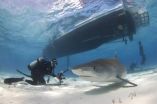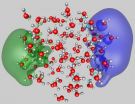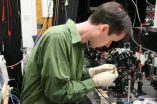(Press-News.org) Los Angeles, Calif. (June 27, 2011) — Why is antibody diversity important? Think about it like this, said Myron Goodman, who is an author on the paper: "Why don't you die when I sneeze? It's because you have a powerful immune system. And the way to get a decent immune system is for your body to have a way to respond to insults it has never seen before."
Random patterns of deamination by the enzyme activation-induced deoxycytidine deaminase (AID) are the key to generating antibody diversity, a crucial component to a healthy immune system, according to a new study by researchers at the USC Dana and David Dornsife College of Letters, Arts and Sciences. The paper, "An Analysis of a Single-stranded DNA Scanning Process in which AID Deaminates C to U Haphazardly and Inefficiently to Ensure Mutational Diversity," was published in The Journal of Biological Chemistry.
Having variation in the types of antibodies produced by your body gives it a fighting chance to respond to those "insults." Antibodies protect against invasion by antigens such as bacteria or viruses by locating them in the body and neutralizing them. To do that, antibodies must bind to antigens. The more variation in the types of antibodies produced by the body, the more likely they will be able to bind to and fight off antigens, which come in many forms.
To create antibody diversity, mutations must occur in the variable region of immunoglobulin genes, the region where antibodies bind to invaders. Generating those mutations has to be a really random process according to Goodman, professor of biological sciences and chemistry in USC Dornsife. This is where AID steps in.
Goodman and his colleagues monitored the actions of AID as it scanned single-stranded DNA or transcribed double-stranded DNA. The enzyme essentially moves back and forth along the DNA strand and sporadically deaminates, or converts, cytosine to uracil triggering a mutation in tri-nucleotide motifs – sequences comprising three bases – found along the DNA.
Unlike most enzymes that are exquisitely efficient in targeting favored motifs, they found that AID was extremely inefficient. AID initiated chemical reactions in favored motifs only about 3 percent of the time. By mutating the motifs so haphazardly, the researchers suggest that AID produces antibody diversity.
The study also sheds light on a little-studied group of enzymes. Enzymes such as AID that scan single-stranded DNA have been studied far less extensively than enzymes that scan double-stranded DNA.
"This is the first really clear picture of what AID is doing during the scanning process," Goodman said.
To identify and describe AID's complex process during scanning, the team used a genetic assay to measure the distribution of AID-induced mutations on individual DNA molecules and then analyzed the mutational data computationally using a random walk model, developed for the study by USC Dornsife researcher Peter Calabrese. By combining the genetic and computational analyses, they were able to calculate the distribution of mutations that occurred with a remarkable fit to their experimental data. The fit entailed matching theory to experiment for the patterns of closely spaced mutations and separately for the distances between mutated and non-mutated target motifs.
###
Their paper, published online May 12, was selected by The Journal of Biological Chemistry as a "Paper of the Week" in the July 15 print issue. The distinction is bestowed by the publication's editorial board members and associate editors to papers that represent the top 1 percent of papers reviewed in terms of significance and overall importance.
Authors on the paper are from USC Dornsife and include Phuong Pham, assistant professor (research) of biological sciences; Calabrese, assistant professor (research) of biological sciences; Goodman, professor of biological sciences and chemistry; and Soo Jung Park, research assistant. The National Institutes of Health funded the study.
Watch the video "The Dynamics of Single-stranded DNA Deamination by AID": http://www.youtube.com/watch?v=-RnaHLskLwo
About USC Dana and David Dornsife College of Letters, Arts and Sciences (http://dornsife.usc.edu): USC Dana and David Dornsife College of Letters, Arts and Sciences is the heart of the University of Southern California. The largest, oldest and most diverse of USC's 19 schools, USC Dornsife is composed of more than 30 academic departments and dozens of research centers and institutes. USC Dornsife is home to approximately 10,000 undergraduate and graduate students and more than 750 faculty members with expertise across the humanities, social sciences and sciences.
Disorderly enzyme is key for antibody diversity
USC Dornsife researchers uncover how the inefficiency of activation-induced deoxycytidine deaminase is good for your immune system
2011-06-28
ELSE PRESS RELEASES FROM THIS DATE:
QueTech, LLC Announces the Launch of its First Division: FlexTherapistCEUs.com
2011-06-28
Quantum Units Continuing Education has joined forces with ITech Solutions to combine their specializations: the former providing CEUs to mental health and substance abuse professionals and the latter providing web development and programming. Together they have created QueTechCeus.com and launched its first division web site: http://www.FlexTherapistCeus.com.
Flex CEUs has received recognition by the California Board of Physical Therapy as an approval agency for continuing education competency for physical therapists. As well, Flex CEUs provides continuing education ...
Advances in delivery of therapeutic genes to treat brain tumors
2011-06-28
New Rochelle, NY, June 27, 2011—Novel tools and methods for delivering therapeutic genes to cells in the central nervous system hold great promise for the development of new treatments to combat incurable neurologic diseases. Five of the most exciting developments in this rapidly advancing field are presented in a series of articles in the June issue of Human Gene Therapy, a peer-reviewed journal published by Mary Ann Liebert, Inc. (www.liebertpub.com). The articles are available free online at www.liebertpub.com/hum
A review article by Betley and Sternson, "Adeno-Associated ...
From the wild to the wonderful: annual exhibition of Scottish art at the Red Rag Gallery, Stow on the Wold, UK (from Sunday, 10 July 2011).
2011-06-28
This colourful show will give an up to date insight into the vibrant, contemporary Scottish art scene. Contributors span several generations of contemporary artists with Scottish roots or who have emerged through the Scottish art colleges, imbued with the fine traditions of Scottish art.
This varied and engaging show will, as ever, include a range of styles, media and subjects - 'from the wild to the wonderful' -
From the expansive landscapes and seascapes of Robert Kelsey to the more intimate landscapes of Lynn Rodgie, the townscapes of Stephanie Dees and the colourful ...
Safety issue revealed as 1 in 20 Australian workers admits to drinking at work
2011-06-28
A national survey has found that more than one in twenty Australian workers report using alcohol while at work or just before work, and more than one in fifty report taking drugs during or just before work. These findings, published online today in the journal Addiction, have implications for workplace safety.
Researchers used data from the 2007 National Drug Strategy Household Survey (NDSHS), which polled over 23,000 Australian residents aged 12 and over on their use of alcohol, tobacco, and other drugs. The resulting statistics showed that working while under the ...
Conservation dollars and sense
2011-06-28
MIAMI – Shark populations over the last 50 years have decreased dramatically. From habitat degradation to overfishing and finning, human activities have affected their populations and made certain species all but disappear.
A new article in Current Issues in Tourism by Austin J. Gallagher and Dr. Neil Hammerschlag of the R.J. Dunlap Marine Conservation Program at the University of Miami study the impact of these apex predators on coastal economies and the importance of including conservation efforts in long term management plans.
The team collected data from a total ...
Scientists discover dielectron charging of water nano-droplet
2011-06-28
Scientists have discovered fundamental steps of charging of nano-sized water droplets and unveiled the long-sought-after mechanism of hydrogen emission from irradiated water. Working together at the Georgia Institute of Technology and Tel Aviv University, scientists have discovered when the number of water molecules in a cluster exceeds 83, two excess electrons may attach to it — forming dielectrons — making it a doubly negatively charged nano droplet. Furthermore, the scientists found experimental and theoretical evidence that in droplets comprised of 105 molecules or ...
International team demonstrates subatomic quantum memory in diamond
2011-06-28
(Santa Barbara, Calif.) –– Physicists working at the University of California, Santa Barbara and the University of Konstanz in Germany have developed a breakthrough in the use of diamond in quantum physics, marking an important step toward quantum computing. The results are reported in this week's online edition of Nature Physics.
The physicists were able to coax the fragile quantum information contained within a single electron in diamond to move into an adjacent single nitrogen nucleus, and then back again using on-chip wiring.
"This ability is potentially useful ...
Female mate choice enhances offspring fitness in an annual herb
2011-06-28
In many organisms females directly or indirectly select mates (or sperm) and potentially influence the fitness of their offspring. Mate choice and sexual selection in plants is more complex in some ways than in animals because plants are sessile organisms and often have to rely on external vectors, such as animals, for pollen transport. As such, there is only so much a plant can do to affect the timing of pollen arrival, or the size and diversity of deposited pollen. But can a plant control which pollen grains, of the hundreds that land on their stigmas, make it to the ...
Studies examine impact of media use among youth, recommend preventative measures
2011-06-28
SEATTLE – June 27, 2011 – In today's society where access to media is ever present, many parents worry about what is appropriate media usage for their children and how media consumption can potentially affect them. Two new studies led by Dr. Dimitri A. Christakis, MD, MPH and Dr. Michelle M. Garrison, PhD of Seattle Children's Research Institute, focus on different uses of media and assess how media usage can lead to depression in college students and disrupt sleep patterns in preschool aged children. The results of Dr. Christakis' study, "Problematic Internet Usage in ...
Fossilized pollen reveals climate history of northern Antarctica
2011-06-28
VIDEO:
Rice University scientist John Anderson discusses what researchers have learned from studying the first direct and detailed climate record from the continental shelves surrounding Antarctica, and he describes the years...
Click here for more information.
HOUSTON -- (June 27, 2011) -- A painstaking examination of the first direct and detailed climate record from the continental shelves surrounding Antarctica reveals that the last remnant of Antarctic vegetation ...
LAST 30 PRESS RELEASES:
Heart-brain connection: international study reveals the role of the vagus nerve in keeping the heart young
Researchers identify Rb1 as a predictive biomarker for a new therapeutic strategy in some breast cancers
Survey reveals ethical gaps slowing AI adoption in pediatric surgery
Stimulant ADHD medications work differently than thought
AI overestimates how smart people are, according to HSE economists
HSE researchers create genome-wide map of quadruplexes
Scientists boost cell "powerhouses" to burn more calories
Automatic label checking: The missing step in making reliable medical AI
Low daily alcohol intake linked to 50% heightened mouth cancer risk in India
American Meteorological Society announces Rick Spinrad as 2026 President-Elect
Biomass-based carbon capture spotlighted in newly released global climate webinar recording
Illuminating invisible nano pollutants: advanced bioimaging tracks the full journey of emerging nanoscale contaminants in living systems
How does age affect recovery from spinal cord injury?
Novel AI tool offers prognosis for patients with head and neck cancer
Fathers’ microplastic exposure tied to their children’s metabolic problems
Research validates laboratory model for studying high-grade serous ovarian cancer
SIR 2026 delivers transformative breakthroughs in minimally invasive medicine to improve patient care
Stem Cell Reports most downloaded papers of 2025 highlight the breadth and impact of stem cell research
Oxford-led study estimates NHS spends around 3% of its primary and secondary care budget on the health impacts of heat and cold in England
A researcher’s long quest leads to a smart composite breakthrough
Urban wild bees act as “microbial sensors” of city health.
New study finds where you live affects recovery after a hip fracture
Forecasting the impact of fully automated vehicle adoption on US road traffic injuries
Alcohol-related hospitalizations from 2016 to 2022
Semaglutide and hospitalizations in patients with obesity and established cardiovascular disease
Researchers ‘listen in’ to embryo-mother interactions during implantation using a culture system replicating the womb lining
How changing your diet could help save the world
How to make AI truly scalable and reliable for real-time traffic assignment?
Beyond fragmented markets: A new framework for efficient and stable ride-pooling
Can shape priors make road perception more reliable for autonomous driving?
[Press-News.org] Disorderly enzyme is key for antibody diversityUSC Dornsife researchers uncover how the inefficiency of activation-induced deoxycytidine deaminase is good for your immune system





